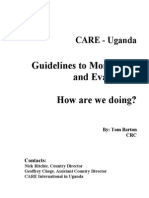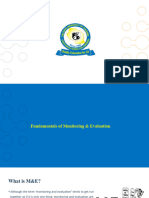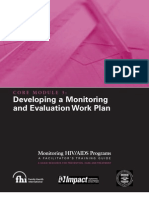100%(8)100% found this document useful (8 votes)
3K viewsProject Monitoring & Evaluation
Project monitoring and evaluation ppt covering all aspects of evaluation of a project and monitoring it.
Uploaded by
Sreekanth'z SreekCopyright
© © All Rights Reserved
Available Formats
Download as PPT, PDF, TXT or read online on Scribd
100%(8)100% found this document useful (8 votes)
3K viewsProject Monitoring & Evaluation
Project monitoring and evaluation ppt covering all aspects of evaluation of a project and monitoring it.
Uploaded by
Sreekanth'z SreekCopyright
© © All Rights Reserved
Available Formats
Download as PPT, PDF, TXT or read online on Scribd
You are on page 1/ 42
What is Monitoring?
Looking into the process, going towards the
target, right selection of beneficiaries
Procedures are being followed according to the
work plan
Meeting our target or not (target monitoring),
activity monitoring
Continuous info collection/analysis/reporting for
decision making
Program is going in right direction as planned in
the project document
One line definition
Monitoring is the recording
Whether right thing is being delivered to the
right people at the right time in a right way
(process)
Monitoring
Systematic recording of :
Observations
Information gathering
Analysis
Documentation
Reflection and
Action..re-planning
What is not Monitoring
Policing/imposing
Pointing out (but it is highlighting)
The Need for Monitoring and Evaluation
There are many reasons for carrying out project M&E.
Project managers and other stakeholders need to
know the extent to which their projects are meeting their
objectives and leading to their desired effects.
M&E build greater transparency and accountability in
terms of use of project resources.
Information generated through M&E provide project
staff with a clearer basis for decision-making.
Future project planning and development is improved
when guided by lessons learned from project
experience.
Salih
Project Monitoring
Monitoring represents an on-going
activity to track project progress against
planned tasks.
It aims at providing regular oversight of
the implementation of an activity in terms
of input delivery, work schedules,
targeted outputs etc.
Through such processes, project
monitoring aims at:
1) Providing project management, staff and other
stakeholders with information on whether progress
is being made towards achieving project
objectives. In this regard, monitoring represents a
continuous assessment of project implementation
in relation to project plans, resources,
infrastructure, and use of services by project
beneficiaries.
2) Providing regular feedback to enhance the
ongoing learning experience and to improve the
planning process and effectiveness of
interventions.
3) Increasing project accountability with donors
and other stakeholders.
4) Enabling managers and staff to identify and
reinforce initial positive project results, strengths
and successes. As well, monitoring alerts
managers to actual and potential project
weaknesses, problems and shortcomings before
it is too late. This would provide managers with
the opportunity to make timely adjustments and
corrective actions to improve the
program/project design, work plan and
implementation strategies.
5) Checking on conditions or situations of a
target group, and changes brought about by
project activities. In this regard, monitoring
assists project management to check whether
the project continues to be relevant to the target
group and/or geographical area, and whether
project assumptions are still valid.
Rasna
Monitoring actions must be undertaken throughout
the lifetime of the project. Evaluation researches
might be needed when unexpected problems arise
for which planned monitoring activities cannot
generate sufficient information, or when socio
economic or environmental conditions change
drastically in the target area.
Effective monitoring needs adequate planning,
baseline data, indicators of performance, and
results and practical implementation mechanisms
that include actions such as field visits, stakeholder
meetings, documentation of project activities,
regular reporting, etc. Project monitoring is
normally carried out by project management, staff
and other stakeholders.
What monitoring should be doing ?
Monitoring Tools
Staff meetings Weekly, Monthly, Annual
Partners meeting/Learning Forums (FGD,
Surveys)/Retreat
Participatory Reviews Stakeholders
Monitoring and Supervision Mission
(Self/Donors/Joint)
Progress reports/Statistics
To ensure that inputs, activities and outputs proceed
according to plan
Determine whether the inputs are optimally utilized
Ensuring all activities are carried out by the right people
and in time
To provide record of inputs, activities, and outputs
To warn of deviations from objectives
To assist managers in making decisions
Monitoring should take place at and be integrated into all
stages of the project cycle
Goals of Monitoring
Shiga
Project Evaluation
Program/project evaluation represents a
systematic and objective assessment of ongoing
or completed projects or programs in terms of
their design, implementation and results.
In addition, evaluations usually deal with strategic
issues such as program/project relevance,
effectiveness, efficiency (expected and
unexpected), in the light of specified objectives,
as well as program/project impact and
sustainability.
Project Evaluation
Periodic evaluations of ongoing projects are
conducted to review implementation progress,
predict project's likely effects and highlight
necessary adjustments in project design. Terminal
evaluations (or final evaluations) are evaluations
carried out at the end of a project to provide an
overall assessment of project performance and
effects/impact, as well as to assess the extent to
which the project has succeeded in meeting their
objectives and their potential sustainability.
Reasons for Project Evaluation
There are many reasons for conducting an evaluation,
including:
1) Providing managers with information regarding
project performance. Project plans might change
during the implementation process. Evaluations can
verify if the program is really running as originally
planned. In addition, they provide signs of project
strengths and weaknesses, and therefore, enable
managers to improve future planning, delivery of
services and decision-making.
2) Assisting project managers, staff and other
stakeholders to determine in a systematic and
objective manner the relevance, effectiveness, and
efficiency of activities (expected and unexpected) in
light of specified objectives.
Project Evaluation
3) Mid-term evaluations may serve as a means of
validating the results of initial assessments
obtained from project monitoring activities.
4) If conducted after the termination of a
program/project, an evaluation determines the
extent to which the interventions are successful in
terms of their impact and sustainability of results.
5) Assisting managers to carry out a thorough review
and re-thinking about their projects in terms of their
goals and objectives, and means to achieve them.
Project Evaluation
6) Generating detailed information about project
implementation process and results. Such
information can be used for public relations,
fundraising, promotion of services in the
community, as well as identifying possibilities
for project replication.
7) Improving the learning process. Evaluations
often document and explain the causes as to
why activities succeeded or failed. Such
documentation can help in making future
activities more relevant and effective.
Sherin
Steps in Evaluation
Phase A: Planning the Evaluation
Phase B: Selecting Appropriate Evaluation Methods
Phase C: Collecting and Analyzing Information
Phase D: Reporting/disseminating Findings
Phase E: Implementing Evaluation Recommendations
Phase A: Planning the Evaluation
Determine the purpose of the evaluation.
Decide on type of evaluation.
Review existing information of programme
documents including monitoring information.
Describe the programme.
Develop/refine conceptual framework.
Assess your own strengths and limitations.
Put together an evaluation team including
stakeholders.
Phase B: Selecting Appropriate
Evaluation Methods
Identify evaluation goals and objectives
Formulate evaluation questions and sub-
questions
Decide on the appropriate evaluation
design.
Develop an evaluation schedule
Develop a budget for the evaluation.
Phase C: Collecting and Analyzing
Information
Develop data collection instruments.
Pre-test data collection instruments.
Undertake data collection activities.
Analyze data.
Interpret the data.
Phase D: Reporting/disseminating
Findings
Write the evaluation report.
Decide on the method of sharing the evaluation
results.
Decide on communication strategies.
Share the draft report with stakeholders and
revise as needed.
Disseminate evaluation report.
Meet with project stakeholders to discuss and
follow-up on findings once they have accepted
the findings.
Phase E: Implementing Evaluation
Recommendations
Develop a new/revised implementation
plan in partnership with stakeholders.
Monitor the implementation of evaluation
recommendations and report regularly on
the implementation progress.
Plan the next evaluation.
Wafa
Some Evaluation Methods
Theory-based evaluation
Formal surveys
Rapid appraisal methods
Cost-benefit and cost-effectiveness
analysis
Participatory methods
Public expenditure tracking surveys
Impact evaluation
Relationship between Monitoring and
Evaluation
Monitoring and evaluation are two different
management tools that are closely related,
interactive and mutually supportive.
Through routine tracking of project progress,
monitoring can provide quantitative and qualitative
data useful for designing and implementing project
evaluation exercises.
On the other hand, evaluations support project
monitoring. Through the results of periodic
evaluations, monitoring tools and strategies can be
refined and further developed.
Difference between
Monitoring and Evaluation
Object
ive
Monitoring Evaluation
To track changes
from baseline
conditions to
desired outcomes.
To validate what results
were achieved, and how
and why they were or
were not achieved.
Metho
dology
Tracks and
assesses
performance
through analysis
and comparison of
indicators over
time.
Evaluates achievement or
outcomes by comparing
indicators before and after
the intervention.
Involves Value Judgment
Relies on monitoring data
and information from
external sources.
Charact
eristics
Continuous and
systematic by
Programme/ Project
Managers and key
partners.
Time-bound,
periodic, in-depth.
Internal or External
evaluators and
partners.
Uses
Alerts managers
about problems in
performance,
provides options
for corrective actions
and helps
demonstrate
accountability.
Provides managers /
Donors /
stakeholders with
strategy
and policy options,
provides basis for
learning and
demonstrates
accountability.
Project Control
Project control can be defined as
management action, either preplanned to
achieve the desired result or taken as a
corrective measure prompted by the
monitoring process. It is concerned with
matrix of the project such as quantities,
time, cost and other resources.
In simple words, project controls
encompass the people, processes and
tools used to plan, manage and mitigate
cost and schedule issues and any risk
events that may impact a project.
Two major functions of Project Control
To ensure regular monitoring of
performance
It motivates project personnel to strive for
achieving objectives.
Effective control critical for realization of
project objectives. There are 3 reasons for
poor project control.
1.Characteristics of project.
2.People problem.
3.Poor control and information system.
There are two main approaches to project
control.
1. Variance Analysis Approach
2. Performance Analysis
Variance Analysis Approach
The traditional approach to project control
involves comparison of actual cost with the
budgeted cost to determine the variance.
The variance analysis approach is inadequate
for the project control for the following reasons.
1. It is backward looking rather than forward
looking.
2. It does not use the data effectively to provide
integrated control.
Performance Analysis
A better approach to control.
Effective control over a project requires
systematic performance analysis.
The following questions need to be answered.
1. Is the project as a whole on schedule, ahead of
schedule or behind schedule?
2. Has the cost of project as a whole been as per
budget estimates, less than budget estimates?
3. What is the trend of performance?
Performance analysis seeks to remove the
subjectivity by employing an analytical
framework based on the following terms:
BCWS (Budgeted Cost of Work Schedule)
BCWP (Budgeted Cost for Work Performed)
ACWP (Actual Cost of Work Performed)
BCTW (Budgeted Cost for Total Work)
ACC (Additional Cost for Completion)
You might also like
- Written Test For Monitoring and Evaluation Officer71% (7)Written Test For Monitoring and Evaluation Officer10 pages
- 2020 Guide On Monitoring and Evaluation For Beginners100% (5)2020 Guide On Monitoring and Evaluation For Beginners30 pages
- Practical Monitoring and Evaluation: A Guide For Voluntary Organisations100% (8)Practical Monitoring and Evaluation: A Guide For Voluntary Organisations139 pages
- Topic 3 - Models of Monitoring and Evaluation - Types of Evaluation Process, Outcome and Impact100% (1)Topic 3 - Models of Monitoring and Evaluation - Types of Evaluation Process, Outcome and Impact54 pages
- File 5 - Module e - Monitoring & Evaluation For Ffa 20 July 2011100% (2)File 5 - Module e - Monitoring & Evaluation For Ffa 20 July 201145 pages
- Guidelines To Monitoring and Evaluation - CARE UgandaNo ratings yetGuidelines To Monitoring and Evaluation - CARE Uganda153 pages
- Monitoring & Evaluation of Social Marketing Programs100% (2)Monitoring & Evaluation of Social Marketing Programs38 pages
- Monitoring, Evaluation, Accountability and Learning (Meal Dpro)100% (3)Monitoring, Evaluation, Accountability and Learning (Meal Dpro)25 pages
- Monitoring & Evaluation Framework - Fiinovation100% (3)Monitoring & Evaluation Framework - Fiinovation19 pages
- Project Monitoring and Evaluation NotesNo ratings yetProject Monitoring and Evaluation Notes49 pages
- Chapter 5 Project Monitoring and Evaluation100% (1)Chapter 5 Project Monitoring and Evaluation26 pages
- Session II For Pres.-Aausc-Open-Pme - Ppts. - Project M & e - OverviewNo ratings yetSession II For Pres.-Aausc-Open-Pme - Ppts. - Project M & e - Overview45 pages
- Day - 1 - Intermediate and Advanced M&E Training100% (1)Day - 1 - Intermediate and Advanced M&E Training71 pages
- Chapter 5 Project Implementation, Monitoring and Evlauation100% (2)Chapter 5 Project Implementation, Monitoring and Evlauation18 pages
- Monitoring and Evaluation in EmergenciesNo ratings yetMonitoring and Evaluation in Emergencies31 pages
- Discuss The Differences Between Monitoring and EvaluationNo ratings yetDiscuss The Differences Between Monitoring and Evaluation21 pages
- EA PM&E Toolkit Resources For Publication PDFNo ratings yetEA PM&E Toolkit Resources For Publication PDF8 pages
- Principles of Monitoring & Evaluation - Notes100% (2)Principles of Monitoring & Evaluation - Notes113 pages
- Assessing Project Monitoring and EvaluatNo ratings yetAssessing Project Monitoring and Evaluat63 pages
- 7 Monitoring and 10 Evaluation Types To Boost Your M&E Strategy100% (1)7 Monitoring and 10 Evaluation Types To Boost Your M&E Strategy6 pages
- Planning Monitoring and Evaluation for Public and Private SectorsFrom EverandPlanning Monitoring and Evaluation for Public and Private SectorsNo ratings yet
- 1TGC901080M0202 - System Clock Manual V2.3No ratings yet1TGC901080M0202 - System Clock Manual V2.322 pages
- Tackling Disablist Language Based Bullying in School: A Teacher's GuideNo ratings yetTackling Disablist Language Based Bullying in School: A Teacher's Guide28 pages
- Enneagram: TWO: A. SELF-PRESERVATION: Focus On PrivilegeNo ratings yetEnneagram: TWO: A. SELF-PRESERVATION: Focus On Privilege4 pages
- Manual of Pesticide Residue Analysis Volume II PDFNo ratings yetManual of Pesticide Residue Analysis Volume II PDF493 pages
- Written Test For Monitoring and Evaluation OfficerWritten Test For Monitoring and Evaluation Officer
- 2020 Guide On Monitoring and Evaluation For Beginners2020 Guide On Monitoring and Evaluation For Beginners
- Practical Monitoring and Evaluation: A Guide For Voluntary OrganisationsPractical Monitoring and Evaluation: A Guide For Voluntary Organisations
- Topic 3 - Models of Monitoring and Evaluation - Types of Evaluation Process, Outcome and ImpactTopic 3 - Models of Monitoring and Evaluation - Types of Evaluation Process, Outcome and Impact
- File 5 - Module e - Monitoring & Evaluation For Ffa 20 July 2011File 5 - Module e - Monitoring & Evaluation For Ffa 20 July 2011
- Guidelines To Monitoring and Evaluation - CARE UgandaGuidelines To Monitoring and Evaluation - CARE Uganda
- Monitoring & Evaluation of Social Marketing ProgramsMonitoring & Evaluation of Social Marketing Programs
- Monitoring, Evaluation, Accountability and Learning (Meal Dpro)Monitoring, Evaluation, Accountability and Learning (Meal Dpro)
- Session II For Pres.-Aausc-Open-Pme - Ppts. - Project M & e - OverviewSession II For Pres.-Aausc-Open-Pme - Ppts. - Project M & e - Overview
- Chapter 5 Project Implementation, Monitoring and EvlauationChapter 5 Project Implementation, Monitoring and Evlauation
- Discuss The Differences Between Monitoring and EvaluationDiscuss The Differences Between Monitoring and Evaluation
- 7 Monitoring and 10 Evaluation Types To Boost Your M&E Strategy7 Monitoring and 10 Evaluation Types To Boost Your M&E Strategy
- Planning Monitoring and Evaluation for Public and Private SectorsFrom EverandPlanning Monitoring and Evaluation for Public and Private Sectors
- Tackling Disablist Language Based Bullying in School: A Teacher's GuideTackling Disablist Language Based Bullying in School: A Teacher's Guide
- Enneagram: TWO: A. SELF-PRESERVATION: Focus On PrivilegeEnneagram: TWO: A. SELF-PRESERVATION: Focus On Privilege
- Manual of Pesticide Residue Analysis Volume II PDFManual of Pesticide Residue Analysis Volume II PDF

























































































